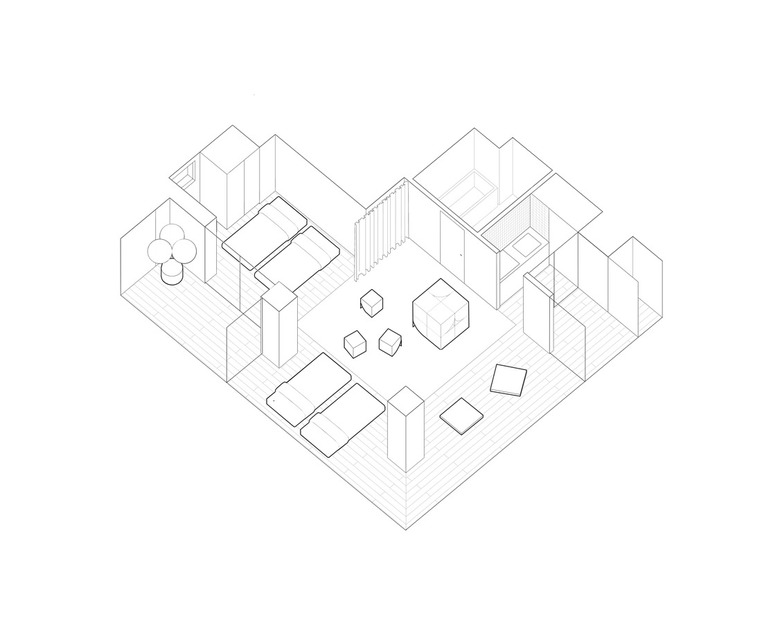
LIGHTHOUSE
Hotel / Residence

Shinjuku,Tokyo, Japan
2020.07
Hotel / Residence
GOOD DESIGN AWARD 2021 winner









(English bellow)
建築概要
Light Houseは東京都新宿区に建つホテルである。当初はホテルとして計画されたが、新型コロナウィルスの影響により、工事途中に居住施設へと変更された稀なプロジェクトである。
結果として、ホテルとしての非日常的な空間構成を逆手にとり、コロナ禍に求められる新たな日常的空間が創出されたデザインとなっている。
地上階とファサード
本建築は早稲田通りに面して建っている。浮遊したタイルファサードが内部と外部、パブリックとプライベートを緩やかにつなぐ役割を果たしている。交差点に向かって大きく穿たれた開口は、都市から戻る旅行者や居住者を迎え入れる。
地上階は本来ホテルのレセプション空間であったが、居住者のための空間としてコーワキングスペースへと転換した。コロナ禍において求められる在宅ワークに対応した空間としている。
居室空間
6-8人の核家族が来日した場合、ビジネスホテルだと2-3室の予約が必要となる。せっかく、大家族で訪日したのに夜を共に過ごすことが難しく、騒音を気にして隣室を気にせず屋内で楽しい時間を過ごすことすらままならない。そこで、本計画では各階はワンフロア、ワンルームの客室として計画することで、各階を一大家族専用の空間となるように設計した。正方形平面の中心に土間的な場所を設け、その周りには様々なアクティビティがうまれるプラットフォームを用意した。その区切りには、ブラインドやカーテンを用いることで閉じていても他所の気配をかじることができる緩やかな仕切りとした。さらに、各フロアーには日照時間の異なるバルコニーを2つ設けた。朝や夕方では眺める景色を変えたることで異なるバルコニーを自由に選択し、半屋外を楽しむ方法が非日常的で楽しくなるようにした。
これらの一連の設計が、コロナの影響を受けて居住空間となったとき、土間は家族の中心のリビングとして機能しはじめた。緩やかな間仕切はプライバシーを確保するスクリーンとなった。バルコニーは、普通のマンションでは洗濯物が干される場となってしまい半屋外空間を楽しむことが難しい。しかし、二つあることで一方はそのような生活のためのバルコニーとしても、他方は仕事や憩いの空間として使うことが可能である。通常よりも広い本計画のバルコニーはポスト・コロナ時代に期待される半屋外空間の快適性に応えるものである。
ファーニチャー
本計画では、家具もデザインしている。MiwaChair(美波チェア)は、建築のファサードと同じようにR曲線で開かれた形態が特徴である。組み合わせ次第で様々な用途へと可変する。積層させたり、連結させたり、反転させることでテーブル、ベンチ、花瓶などになったりする。これによって、家具から建築、都市へと一体的にデザインされたホテル|レジデンスとすることができたと考えている。
Lighthouse Tokyo is a nine story building who was designed as a hotel in the neighborhood of Shinjuku, Tokyo, and has been delivered as a residence building due to the impact of the COVID-19 in the Tokyo tourism business.
The building is in a crossing along Waseda street. The facade was conceived as concrete levitating sheet, who erase the boundaries between interior and exterior, public and private and opens to the street intersection trough two round cuts inviting people from every direction. The building was thought as a lighthouse for the travelers.
However, due to the change of use into residence, the ground floor was converted into a co-working space for the residents. We realized during the lockdown the convenience of this kind of spaces specially in families with children. The lighthouse became then the expression of the new normality.
The building was planned as a unique room per floor hotel with an open plan developed around the doma space 土間. The doma is in traditional Japanese buildings an area associated with the daily use and the entrance points, and it was the center of the socialization. In this space the guests are allow to enter with shoes and is the place to gather. The doma is surrounded by a raised floor area that becomes a flexible platform for quiet activities and night use. In this shoeless space the futons are placed at night depending on the number of guests. The boundary between the doma and the raised floor can be close using light partitions, wooden blinds, or curtains.
YSLA designed Miwa みわ as a modular and flexible furniture that can be assembled and use in different ways remembering the spirit of the lighthouse in its shape.
Project Credits:
Architecture & Interior: YSLA architects
Curtains: Studio Onder de Linde
Structure: yAt Structure Design Office
Contractor: FUJIKEN
Photography: Munetaka Onodera (when specified)
